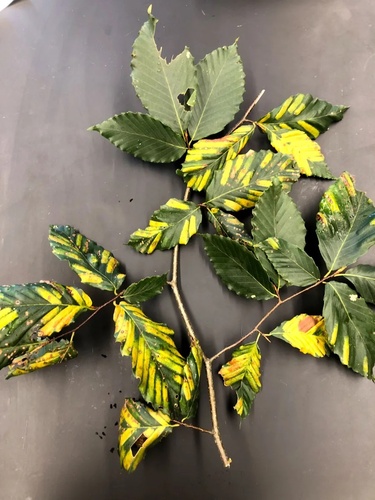For the first time in Vermont, officials with the Vermont Department of Forest, Parks and Recreation have confirmed the presence of a disease that infects the leaves of beech trees.
Beech leaf disease, which was confirmed earlier this month in Vernon and, more recently, in Dummerston, is caused by invasive nematodes that spread in the tree's leaves.
In the United States, the nematodes were first found in Ohio, then identified in 14 states, including New Hampshire, Maine, and Massachusetts, according to Josh Halman, forest health program manager with Vermont's Department of Forests, Parks and Recreation.
The nematodes, which are worm-like creatures native to Japan, "are in such high concentrations within the leaf material that it's actually damaging cells and disrupting the flow of nutrients and water within the leaves," Halman said.
"And so, when you have high enough numbers of these nematodes within the leaves, it can really reduce the ability of the tree to have to photosynthesize and grow properly," he added.
Staff at the department confirmed the disease after local residents submitted photos of potentially infected American beech trees to VTInvasives.org.
"People in Vermont are surprisingly up to date with what's going on in terms of forest health in the region, and so this was somebody who thought it looked suspicious and submitted it," Halman said.
After collecting samples, department staff sent them to the U.S. Department of Agriculture's Forest Service Laboratory, which confirmed the presence of the invasive nematode's DNA.
When leaves are first infected, they begin to develop thick stripes between the veins, which can sometimes coincide with yellowing of the leaves, according to a press release from the Vermont Department of Forest, Parks and Recreation.
In severe cases, the striping area becomes "slightly raised and thicker than normal tissue, which will lead to leaf deformation, premature leaf-drop, and dieback," according to the department. The progression of the diseases is more severe in younger trees.
Scientists don't yet know how the nematode spreads from tree to tree. While no known cure exists, "there's a lot of research going on to see what kind of treatments can be effective for controlling this," Halman said.
For decades, beech trees in Vermont have already been infected with beech bark disease, which gives beech trees bumpy bark. Halman said it's more common to find beech trees infected with beech bark disease than to find trees showing no symptoms.
The two diseases could have compounding impacts, he said, and scientists are currently studying whether beech bark disease could help beech leaf disease become established.
Halman called beech "a great survivor" because it can reproduce through its roots by sending sprouts to create new trees.
"Even if a tree dies, there's new trees that are being generated from its roots immediately," he said.
Halman encouraged Vermonters to report potential beech leaf disease, and any other suspected invasive species, to VTInvasives.org.
This News item by Emma Cotton originally appeared in VtDigger and was republished in The Commons with permission.
